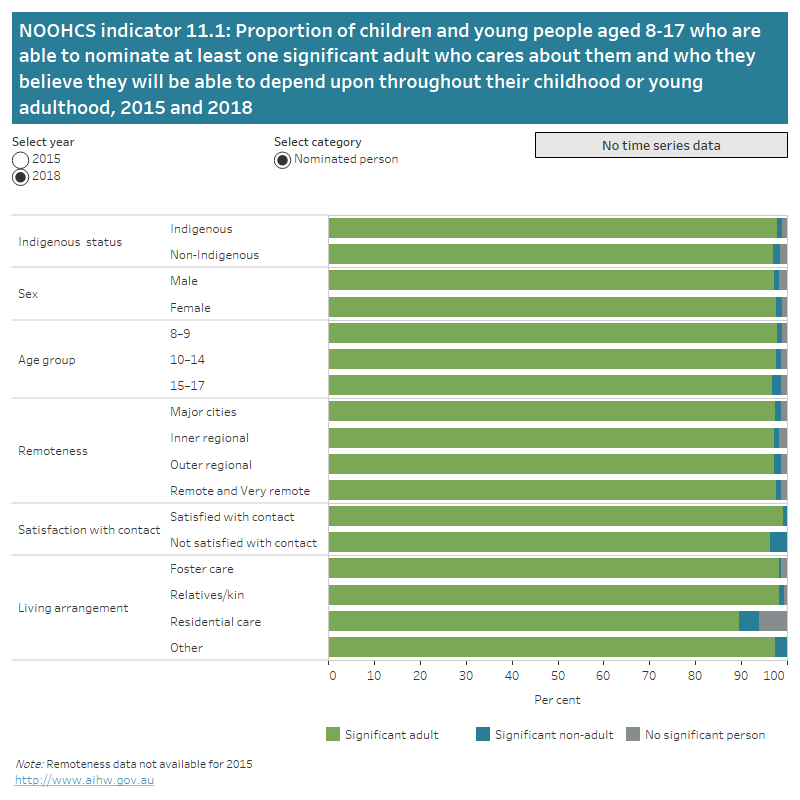11.1 Significant person
Children may be in care due to abuse or neglect, or because their family is unable to care for them (for example, due to illness or incarceration). It is important that children in care have the opportunity to participate in decision-making about their lives.
This indicator uses results from a national survey of children in care; those whose care arrangements have been ordered through the Children’s Court, where parental responsibility for the child or young person has been transferred to the Minister/Chief Executive.
Children were asked about whether they could nominate an adult who cares about them. A question on non-adults was also included so that children who were unable to nominate an adult could identify a broader range of support sources. As an additional measure, children were also asked about their satisfaction with the amount of contact with their nominated person.
Trend data: For all indicator displays, the yearly trend is limited to indicators with 3 or more years (including the current year) of comparable time series data. To see the trend click on “Yearly Trend” button on the display. Where 3 or more years of comparable data including the most recent year is not available, a “No time series data” message is shown on the display.
The horizontal stacked bar graph shows the proportion of children and young people aged 8–17 who are able to nominate at least one significant adult who cares about them and who they believe they will be able to depend upon throughout their childhood or young adulthood. Each bar presented the proportion of children who report each type of nominated person (significant adult, non-adult or no significant person). Data are disaggregated by Indigenous status, sex, age group, remoteness, satisfaction with contact and living arrangement. Data can be selected by year from 2015 or 2018.

Source: AIHW Out-of-home care survey national dataset 2015 and 2018
Note: Categories are mutually exclusive. Only those children unable to nominate a ‘Significant adult’ are included in the ‘Significant non-adult’ category.
See the supplementary data tables for further information and footnotes about these data.
Indicator technical specifications
The information below provides technical specifications for the summary indicator data presented in the quick reference guide.
| Definition | Data source | |
|---|---|---|
| Numerator | Number of children aged 8-17 years in care who report they have a significant adult | AIHW Out-of-home care survey national dataset |
| Denominator | Number of responding children aged 8-17 years in the reference period | AIHW Out-of-home care survey national dataset |
Explanatory notes
Data are sourced from a national survey of children in care. Further interpretive information for the indicators, and background information on the survey, is provided in the AIHW report The views of children and young people in out-of-home care: overview of indicator results from second national survey, 2018.
Children ‘in care’ are those who were residing in out-of-home care (including foster care, relative/kinship care, family group homes, residential care and independent living), whose care arrangements had been ordered by the relevant Children’s Court and where the parental responsibility for the child had been transferred to the Minister or Chief Executive, and who had been on a relevant court order for three months or more. Please note that the titles of the relevant ‘Children’s Courts’ may vary across states/territories.
Children aged 8-17 years were asked the question ‘Do you have an adult who cares about what happens to you now and in the future?’ The question had two response categories: Yes and No. If the child responded ‘No’ they were asked ‘Do you have someone else (who is not an adult) who cares about what happens to you now and in the future?’ The question had two response categories: Yes and No.
The numerator includes children who reported ‘Yes’ to the question.
The numerator and denominator exclude children with a ‘not stated’ response to the questions.


